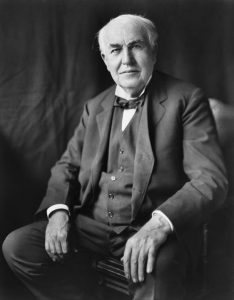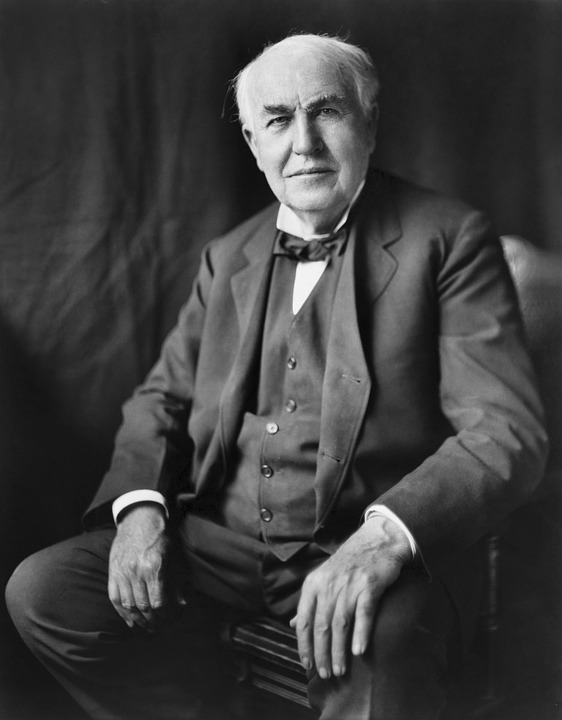“The trouble with our way of educating is that it does not give elasticity to the mind. It casts the brain into a mold. It insists that the child must accept. It does not encourage original thought or reasoning, and it lays more stress on memory than observation.” – Thomas Edison

In 1855, when he was eight years old, Thomas Edison enrolled in school for the first time. After 12 weeks, his teacher, Reverend G. Engle, called him “addled,” or unable to think clearly. Edison apparently hated school and its heavy focus on sitting, memorizing, and repeating. As biographer, Louise Egan, explains: “Tom was confused by Reverend Engle’s way of teaching. He could not learn through fear. Nor could he just sit and memorize. He liked to see things for himself and ask questions.”[1]
Edison’s mother, Nancy Edison, approached Reverend Engle about her son but found his ways too rigid. She felt that he forced things on the children. His mother quickly decided to pull Tom from school and allow him to learn at home, where he developed a passion for books and knowledge. Edison’s education was largely self-directed, with his mother avoiding most top-down instruction and instead allowing Edison to learn naturally. Edison’s biographer, Matthew Josephson, writes: “She avoided forcing or prodding and made an effort to engage his interest by reading him works of good literature and history that she had learned to love…”[2]
Nancy Edison facilitated her son’s learning by noticing the things that interested him and by gathering books and resources to help him explore those topics more fully. Nothing was forced. There was no coercion. Edison became a voracious reader, and by the time he was 12 he had read the great works of Dickens and Shakespeare and many others. He became interested in science so his mother brought him a book on the physical sciences—R.G. Parker’s School of Natural Philosophy—and he performed every experiment within it. This led to a passion for chemistry, so his mother gathered more books for him. Edison spent all of his extra money to gather chemicals from a local pharmacist and to purchase science equipment, and he conducted his first experiments in a makeshift lab in his home’s basement while still just a tween. Josephson writes that in allowing Edison so much freedom and self-direction, his mother “brought him to the stage of learning things for himself, learning that which most amused and interested him, and she encouraged him to go on in that path.” Edison himself wrote about his mother: “She understood me; she let me follow my bent.”[3]
With over 1,000 U.S. patents, Thomas Edison went on to become one of the greatest inventors of all time, creating the phonograph, the motion picture camera, and, most famously, the incandescent light bulb. Books were the foundation of Edison’s education. He was one of the first library cardholders at the Detroit Free Library, and later in his massive laboratory in New Jersey he placed his desk in the center of the lab’s library, surrounded by thousands of books. One of Edison’s chemists, Martin Andre Rosanoff, concluded: “Had Edison been formerly schooled, he might not have had the audacity to create such impossible things…”[4]
Today, I hope that Nancy Edison would have the same confidence and grit to reject her son’s label of addled, or unfocused, and avoid the push to diagnose him with, and medicate him for, an attention disorder like ADHD. What if Edison had stayed in school and were prescribed Adderall, a potent amphetamine drug commonly used to treat ADHD, for his “addled” thinking? Would we all still be sitting in the dark?
For children with a natural tendency to be active and moving, or who don’t learn best by sitting still and listening passively to an adult, school is not a good fit. These children are often frustrated by school and its rigidity, and teachers are frustrated by behavior that can make classroom control an issue. Schooling and normal childhood behaviors are very often incompatible. In fact, many of the families I know who decided to home-school their children–often without ever considering the option before–did so because they realized that schooling was crushing their child’s originality, creativity, and exuberance. Like Nancy Edison, they wanted better for their children.
Boston College psychology professor, Dr. Peter Gray, explains that ADHD diagnoses often begin with teacher evaluations and are fundamentally a school problem–not a child problem. He writes:
“What does it mean to have ADHD? Basically, it means failure to adapt to the conditions of standard schooling. Most diagnoses of ADHD originate with teachers’ observations. In the typical case, a child has been a persistent pain in the neck in school–not paying attention, not completing assignments, disrupting class with excessive movements and verbal outbursts–and the teacher, consequently, urges the parents to consult with a clinician about the possibility that the child has ADHD…. The child may then be put on a drug such as Adderall or Concerta, with the result, usually, that the child’s behavior in school improves. The student begins to do what the teacher asks him to do; the classroom is less disrupted; and the parents are relieved. The drug works.”
ADHD is fundamentally a “failure to adapt to the conditions of standard schooling.” Without schooling, as Dr. Gray discovered upon further research, “most ADHD-diagnosed kids do fine without drugs” and they “do especially well when they are allowed to take charge of their own education.” As schooling lengthens and becomes more restrictive–beginning at ever-earlier ages–ADHD diagnoses and drug treatments are likely to continue to skyrocket. According to data from the National Survey of Children’s Health, up to 15% of children are now diagnosed with ADHD. And between 1991 and 1995, the number of children aged two to four who were prescribed stimulant drugs for alleged attention disorders rose by 300 percent! [5] Toddlers on amphetamines!
Nancy Edison was brave. She saw the energy and creativity in her young son, and also spotted quickly the ways in which schooling smothers both. She removed her son from school and allowed him to learn at home in a self-directed way, through books and hands-on experimentation. She connected him to resources to help him learn and then allowed him the freedom to direct his own education. She rejected schooling in favor of learning for Thomas Edison, and today all of us reap the benefits of her wise parental actions.
[1] Egan, Louise. Thomas Edison: The Great American Inventor. New York: Barron’s Educational Series, Inc., 1987, p. 11.
[2] Josephson, Matthew. Edison: A Biography. New York: John Wiley & Sons, Inc., 1992, p. 22.
[3] ibid.
[4] Josephson, Matthew. Edison: A Biography. New York: John Wiley & Sons, Inc., 1992, p. 412.
[5] Zito, Julie Magno, et al. “Trends in the Prescribing of Psychotropic Medications to Preschoolers,” JAMA 283, no. 8 (2000).

Kerry McDonald
Kerry McDonald has a B.A. in Economics from Bowdoin and an M.Ed. in education policy from Harvard. She lives in Cambridge, Mass. with her husband and four never-been-schooled children. Follow her writing at Whole Family Learning.
This article was originally published on FEE.org. Read the original article.

